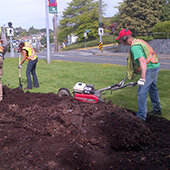Horticulture Practices We Use In Our Beautiful Displays
- Plant Selection
- Pre-Plant Bed Preparation

- Adding Plants
- “Dead Heading” Bedding Plants
- Pruning
- Watering Plants
- Mulching
- Weed Management
Plant Selection
The many plant varieties available in Victoria can make garden design and plant selection challenging. There are so many plants to choose from and possible combinations that it can be difficult to decide which to include. In addition our horticulturists are always looking for new and interesting plants to showcase in our displays.
We often start our own plants from seeds or cuttings at our nursery. We also propagate a wide variety of tropical plants. When selecting plants, we select healthy stock with established root systems and no sign of disease or pests.
Acclimating bedding plants to outdoor conditions before planting helps them survive and grow faster. Most bedding plants grow in a greenhouse under much less stressful conditions than outdoors. That’s why we set our seedling and tender plants outside in partial shade for 7 to 10 days before transplanting them. This helps them recover more quickly than untreated plants.
Pre-Plant Bed Preparation
We first design the bed to blend in with or accent the existing landscape. Once we have a plan, we order all the plants we need.
Next, we get the bed ready for planting. We:
- Weed the bed
- Rake off any existing mulches
- Add soil amendments
- Till the beds
- Test the irrigation system
- Monitor weather conditions for things like heat, rain or frost
Adding Plants
- We place plants in the bed at the same depth as they are in the pot.
- We plant in soil, not mulch. Mulches don’t have enough nutrients or moisture.
- We plant in preformed planting holes to reduce root damage while transplanting.
- We space plants so beds will be full but not too crowded.
“Dead Heading” Bedding Plants
We “dead head” by removing dead or faded flowers from plants. This makes them more attractive, reduces the chance for diseases and stimulates flowering in many species. We check beds at least every week for dead and faded blossoms.
Pruning
Many shrub species need pruning to maintain their form and to control their growth. Some bedding plants also need pruning to control their size or to stimulate greater flowering, as with some kinds of petunias.
Watering
We use many types of water delivery systems in our horticulture displays. Some are automatic and others are manual. We adjust watering to the species in the plant displays. For the best growing conditions, we control volume, pressure and frequency.
Mulching
A layer of mulch on a planting bed helps suppress weeds, retain moisture and moderate soil temperature. We use different types like leaf and bark mulches.
Weed Management
With our mild climate, weeds even grow in winter! It’s a constant challenge for our horticulture staff. It is impossible to have a completely weed-free bed, but techniques like mulching, proper species selection and cultural practices can reduce the amount of weeds.

